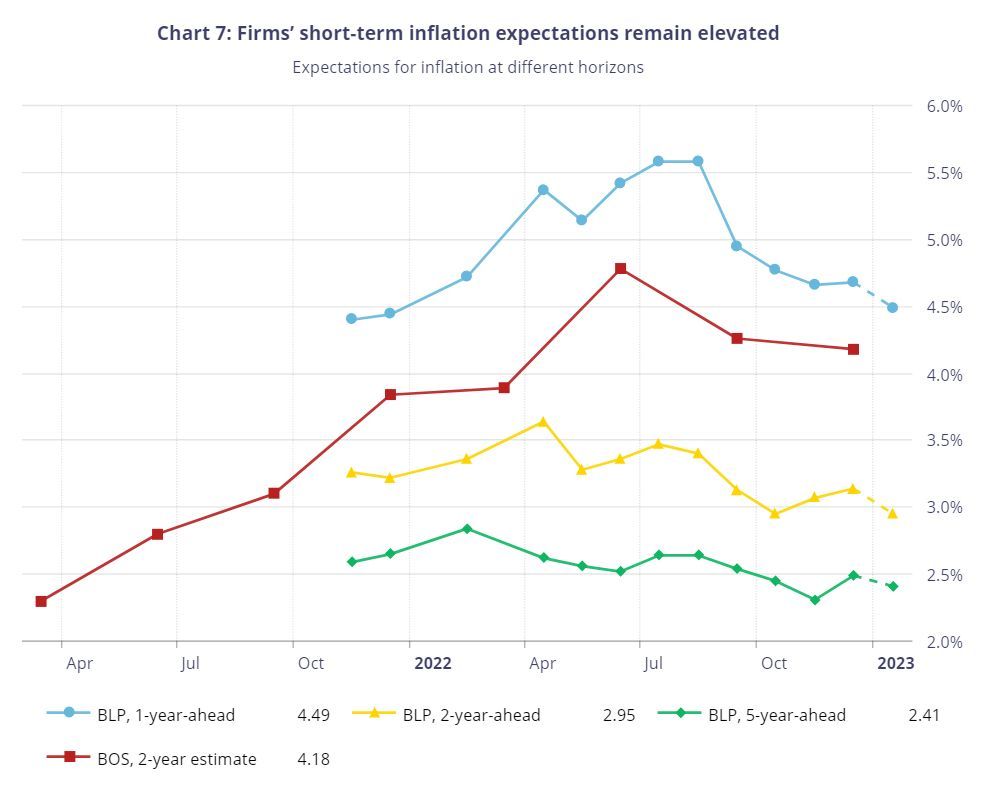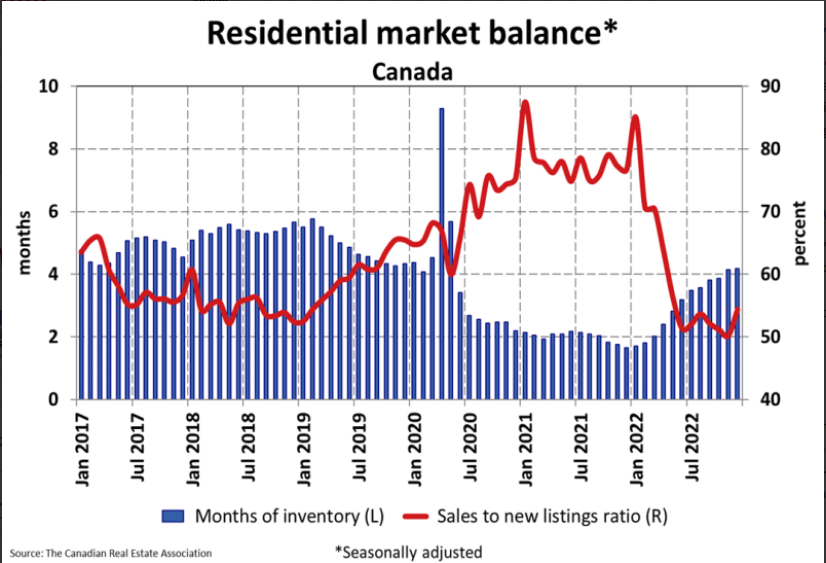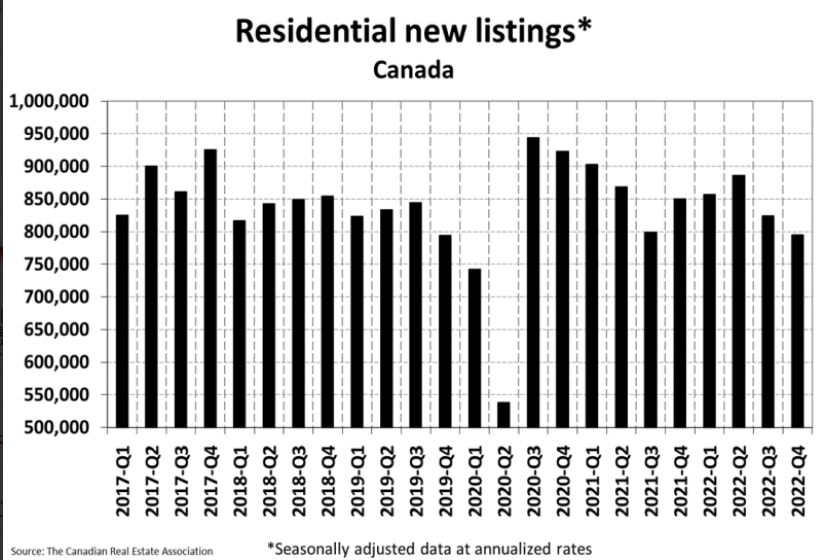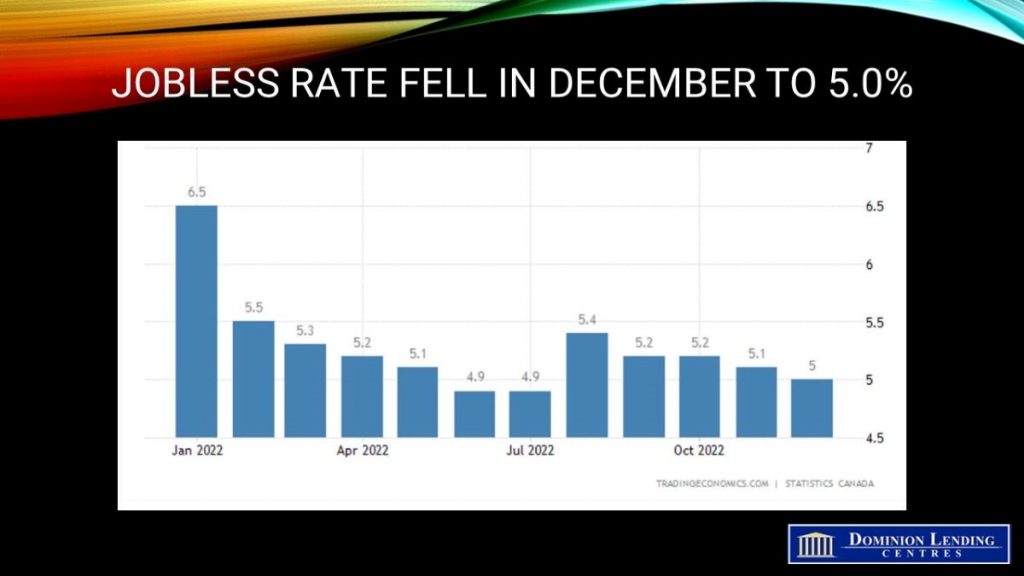‘Tis the season for 2023 housing market predictions in Canada. This year, most economists predict Canada will enter a recession in the first quarter of 2023. Because of this, planning to buy or sell a home can be a challenge. In addition, economic downturns often lead to higher unemployment rates, decreased property values, and less confidence in significant financial decisions — such as purchasing an asset like a home.
These side effects of a recession can lead to a decrease in demand for housing, resulting in lower housing prices. So, what does this mean for buyers and sellers as we head into 2023? When you consider these economic predictions, it can be helpful to understand what’s happening in the housing market from the start of 2022 to today, what the overall change has been, and whether prices are increasing or decreasing.
How Do Major City Home Prices Look Today?
According to the Canadian Real Estate Association (CREA), the national average home price in November 2022 was $632,802. This number is down nearly 12% yearly, but Vancouver and Toronto were the markets that drove this decrease.
With that in mind, we spoke with several real estate professionals to gather their expert opinion on what to anticipate in the next twelve months and how you can prepare your finances as a homeowner, seller, or buyer as we enter a new real estate cycle. Here are their 2023 Canada housing market predictions.
What to Expect If You Plan to Buy a Home in 2023
The good news for buyers is that some major markets will enter a buyer’s market for the first time in a long time. So, even though you need to be more vigilant with your finances, if you can afford a home with current interest rates, there should be fewer difficulties managing homeownership costs soon.
According to real estate investor and podcast host Daniel Foch, here are some things to know if you’re planning to buy a home in 2023. For one, with higher interest rates, more of your monthly payments go towards mortgage interest. “You’ll see a decrease in your buying power or your total purchasing budget as interest rates go up,” says Foch. He also thinks we’ll see stricter lending criteria from mortgage lenders and banks.
The good news? Prices may finally stabilize as we head into a more seasonal real estate cycle, with a busier spring market dipping into the summer and slightly rising in the fall.
Remember that only some markets are down or impacted by the current economic downturn. Therefore, you must stay on top of what’s happening in your local real estate market if you plan to buy in the coming year.
Breakdown: Be patient! Now is the time to get your finances in order and pay attention to the number of homes for sale and the number of homes selling each month in your local market. You have time and negotiation on your side if you’re in a buyer’s market.
How to Proceed When Selling a Home in 2023
Recently, selling a home in Canada has been a wild ride. Bidding wars, bully offers, and lineups for open houses were not uncommon, nor was accepting an offer tens of thousands of dollars over the list price. These unique circumstances weren’t normal, as President & COO of Zolo, Mustafa Abbasi, confirms.
“The last two weren’t normal years for the real estate market. Practically every market in Canada saw double-digit price increases, and bidding wars were normal right across the country.“
Our 2023 housing market predictions in Canada expert expects the new year will present a different landscape for sellers. In fact, we’re already starting to see what that will look like. “According to the Canadian Real Estate Association, activity was down 36% year over year in November 2022, with prices dropping about 10% across the nation.”
Rapidly rising interest rates fueled this slowdown as the Bank of Canada moved to curb inflation. That hasn’t happened yet, so expect more rate hikes in 2023 and a continued cooling of home prices. “We will continue to see the cooling trajectory for the next 12 months,” says Abbasi, adding that sellers shouldn’t expect a bidding war and should expect their home to sit on the market longer, especially in urban centres like Toronto and Vancouver.
Breakdown: 2023 will be a buyer’s market, and sellers should expect their homes to take longer to sell and sell for less. Expect fewer offers, and those you receive will have financing and home inspection conditions.
What Will Mortgage Rates Look Like in 2023?
One of the most significant pain points for homeowners, buyers and sellers this past year has been rising interest rates from the Bank of Canada, sending mortgage rates up alongside them. Unfortunately, higher interest rates will impact almost everyone regardless of their situation.
To gain further insight, we spoke with mortgage broker and author of The Mortgage Code, Angela Calla. “I feel there will still be interest rate hikes in 2023,” says Calla. But, she reminds Canadians that lenders are working to look for new offerings to help. “You are not in this alone.”
If you’re up for mortgage renewal in 2023, you may feel high amounts of pressure and stress. However, Calla says the best thing you can do is start the process early. “If you have a renewal in the next six to 12 months, start consulting with an independent mortgage broker that can consider your whole finances, NOT just the mortgage.”
How Does This Increase Affect My Mortgage?
According to Calla, anyone with a variable-rate mortgage, home equity line of credit (HELOC), or mortgage renewal will immediately see their mortgage payments increase. She says that on a $500,000 mortgage amortized over 25 years, your monthly payments would be:
- 5.5% interest = $2,908.02 per month
- 6.0% interest = $3,109.33 per month
- 6.5% interest = $3,349.12 per month
If you’re looking for a mortgage and are speaking to lenders, you must research and compare rates. “Canadians can not afford to make the costly mistake of looking only at the rate or being sold with a bias during these times,” says Calla.
Should You Choose a Fixed or Variable Rate Mortgage in 2023?
This decision is based entirely on what the market looks like when you purchase or renew. So, hiring a broker you trust and researching market trends is vital. For instance, if you want to choose a fixed-rate mortgage, you may think that inflation will stick around for a while. Or your finances are tight, and you can’t afford fluctuation or potential increases; fixed could be a great choice.
On the flip side, a variable rate mortgage might be the right choice if you believe the Bank of Canada will stop with rate raises and that they may go down in the next one to two years. However, remember that they have yet to allude to rates dropping anytime soon.
Breakdown: Be vigilant with your budget and use a mortgage calculator to better understand your payments on various mortgage rates if you’re up for renewal or plan to buy in 2023.
How Will Home Insurance Costs Change in 2023?
Homeownership costs extend beyond just the mortgage payments. You’ll also need to pay utilities, property taxes, and insurance. Home insurance is an often overlooked expense for new buyers, but homeowners know this is an essential housing expense – and not a fixed one. Home insurance costs can fluctuate, even if you haven’t made a claim.
We wanted to know what to expect for home insurance costs for our 2023 Canada housing market predictions. So we asked John Shmuel, managing editor at RATESDOTCA, to weigh in.
“In general, home insurance rates are trending upward,” Shmuel says, “our latest Home Insuramap showed that average home insurance premiums rose about 5% in 2022.” While past performance doesn’t always predict future results, in this case, we expect rates will rise on average across Canada, although increases will more heavily impact some areas.
“Whether your own premium will increase or not will depend on how many claims have occurred in your area and whether the general trend of those claims are trending higher,” says Shmuel.
That means homes in areas that are prone to more claims will see their rates rise. Rising rates might occur across most of Canada since climate change has increased the number of damaging weather events, leading to more expensive claims. Hurricane Fiona, says Shmuel, was one example of an uncommon weather event leading to expensive insurance payouts.
Should You Change Your Home Insurance Policy in 2023?
If natural disasters are becoming more common, should you update your home insurance policy in 2023? Shmuel says it’s always a good idea to review your coverage, particularly your flood coverage. A recent study from RATESDOTCA found that 32% of Canadians were unaware that a standard home insurance policy lacks flood protection.
“Standard policies do not cover many forms of water damage which, if they were to occur, can be very costly,” says Shmuel. So, consider adding this coverage if your standard policy doesn’t have overland flooding, sewer backup, or seepage coverage. Yes, it will add cost, but protecting your biggest asset is important.
Breakdown: Expect home insurance rates to rise if you live in a disaster-prone area, and review your coverage to ensure you are covered for natural disasters.
Should You Renovate Your Home in 2023?
If you’re considering renovating your home or tackling some outstanding home maintenance projects in 2023, this might be your year to learn to do it yourself. Rebekah Higgs, designer and star of the Canadian TV show DIY MOM, shares her advice for homeowners considering a major renovation in 2023.
“I recommend to my clients that they put off renovating until 2024 if they can,” Higgs says, citing labour shortages in residential service industries and trades. “Start planning for any big renovation plans now, get your drawings and elevations in order, design your space, measure for future projects and thoroughly plan.” Higgs says thorough planning now ensures the renovation cost doesn’t increase due to change orders.
Should You DIY Your Renovation?
If you want to renovate in 2023, consider doing the project yourself or hiring a handyman instead of a contractor. “Trying to do small maintenance and repairs on your own or with a for-hire handyman might be your best option,” says Higgs. She urges anyone considering this route to ask for references and photos of past work. You can even get a criminal record check and verify their ID for extra security.
Breakdown: Consider delaying major projects until 2024, plan well, and DIY small projects in 2023.
How to Prepare For Utility Bills Next Year
This winter came early and with force for Canadians. Because of this temperature drop, analysts predicted that utility bills would increase by up to 100% — which is incredibly overwhelming when you combine these costs with the current economic climate and inflation levels.
With many world events, like the war in Ukraine and the transition to renewable energy globally, the demand for natural gas is rapidly increasing. Typically, each winter has Canadians anticipating rising costs for their utilities, but this year is exceptionally high.
To help homeowners prepare for 2023 utility bills, we spoke with Bruna Drummond, an energy content expert from Rank-it.ca. “Tight supply plus high demand tends to result in shocking bills,” says Drummond.
In Ontario, for example, Drummond says that according to the Ontario Energy Board, average natural gas bills could rise from $64.80 to $163.83 for a typical residential user this winter, depending on the provider.
“Natural gas is the primary heating source in Ontario for 67.20% of energy consumers, according to the Canada Energy Regulator (CER),” says Drummond.
To help prepare, Drummond suggests the following:
- Compare energy providers and rates
- Find out if it’s cheaper to heat the home with electricity or gas
- Check for drafts and seal any cracks around windows and doors
- Clean or replace your AC filter
- Research available rebates in your province or territory
Breakdown: Your utility bills may increase in price. Now is the time to caulk your windows and doors, look for affordable rates, and research rebate opportunities!
TL;DR: 5 Things to Do Now to Prepare for Our 2023 Housing Market Predictions in Canada
Keep your buying, selling, and homeownership costs lost in 2023 by implementing these key tips:
- Homebuyers and sellers should be patient and understand the real estate market in 2023 will be very different than in 2022.
- Be vigilant with your budget, and use a mortgage calculator to understand your payments on various mortgage rates better if you’re up for renewal or plan to buy in 2023.
- Expect home insurance rates to rise if you live in a disaster-prone area, and review your coverage to ensure you are covered for natural disasters.
- Consider delaying major home renovation projects until 2024, plan well, and DIY small projects in 2023.
- Now is the time to caulk your windows and doors, look for affordable rates, and research electricity-saving rebate opportunities!
(This article is courtesy of Zolo)
Angela Calla is an 18-year award-winning woman of influence which sets her apart from the rest. Alongside her team, Angela passionately assists mortgage holders in acquiring the best possible mortgage. Through her presence on “The Mortgage Show” and through her best-selling book “The Mortgage Code“, Angela educates prospective home buyers by providing vital information on mortgages. In light of this, her success awarded her with the 2020Business Leader of the Year Award.
Angela is a frequent go-to source for media and publishers across the country. For media interviews, speaking inquiries, or personal mortgage assistance, please contact Angela at hello@countoncalla.ca or at 604-802-3983.
Click here to view the latest news on our blog.




















